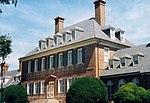Carter's Grove, also known as Carter's Grove Plantation, is a 750-acre (300 ha) plantation located on the north shore of the James River in the Grove Community of southeastern James City County in the Virginia Peninsula area of the Hampton Roads region of Virginia in the United States.
The plantation was built for Carter Burwell, grandson of Robert "King" Carter, and was completed in 1755. It was probably named for both the prominent and wealthy Carter family and nearby Grove Creek. Carter's Grove Plantation was built on the site of an earlier tract known as Martin's Hundred which had first been settled by the English colonists around 1620. In 1976, an archaeological project discovered the site of Wolstenholme Towne, a small settlement downstream a few miles from Jamestown which had been developed in the first 15 years of the Colony of Virginia. The population of the settlement was decimated during the Indian Massacre of 1622.After hundreds of years of multiple owners and generations of families, and the death of the last resident in 1964, Carter's Grove was added to Colonial Williamsburg Foundation's (CW) properties through a gift from the Rockefeller Foundation in 1969.
Carter's Grove was open to tourists for many years but closed its doors to the public in 2003 while CW redefined its mission and role. Later that year, Hurricane Isabel seriously damaged Carter's Grove Country Road, which had linked the estate directly to the Historic Area, a distance of 8 miles (13 km), bypassing commercial and public roadways. CW then shifted some of the interpretive programs to locations closer to the main Williamsburg Historic Area and announced in late 2006 that it would be offered for sale under specific restrictive conditions, including a conservation easement.
In December 2007, CNET founder Halsey Minor acquired the Georgian style mansion and 476 acres (193 ha) for $15.3 million (~$20.9 million in 2022) and announced plans to use it as his home and for a thoroughbred horse breeding program with the Phipps family. The Virginia Outdoors Foundation and the Virginia Department of Historic Resources co-hold the conservation easement on 400 of the 476 acres. However, Minor never lived at the property and filed for personal bankruptcy in 2013. The Colonial Williamsburg Foundation submitted the only bid at the auction held on May 21, 2014, for the outstanding mortgage amount, and announced that it planned to resell it, with a price increased because of significant costs related to the sale, including over $600,000 (~$734,135 in 2022) in necessary repairs. Samuel M. Mencoff, a founder of Madison Dearborn Partners, acquired the property later in 2014.








